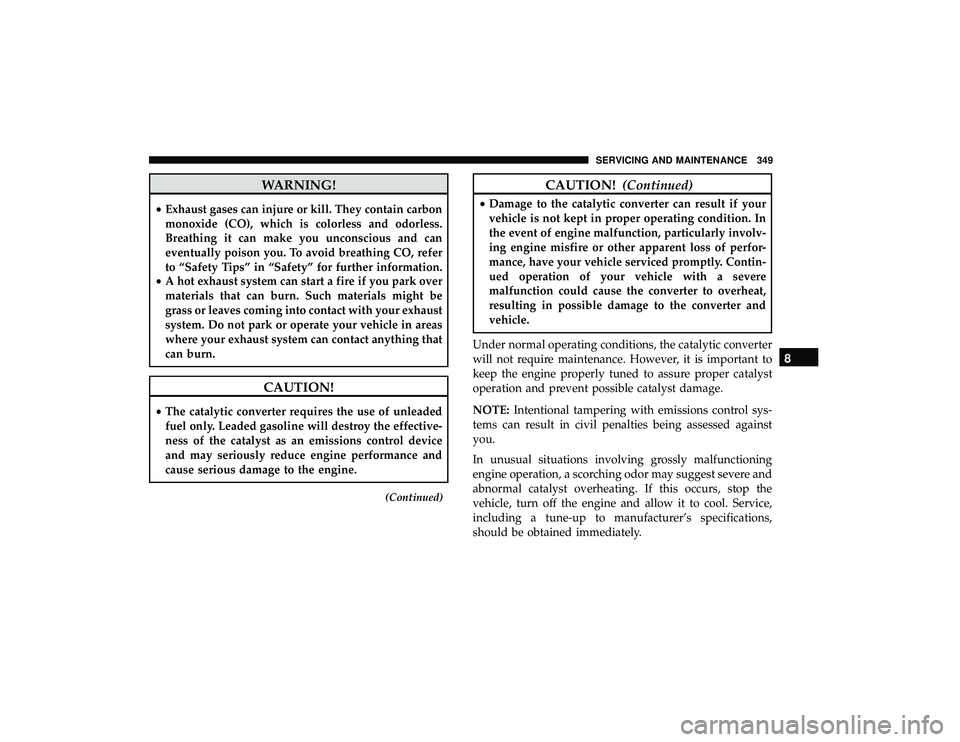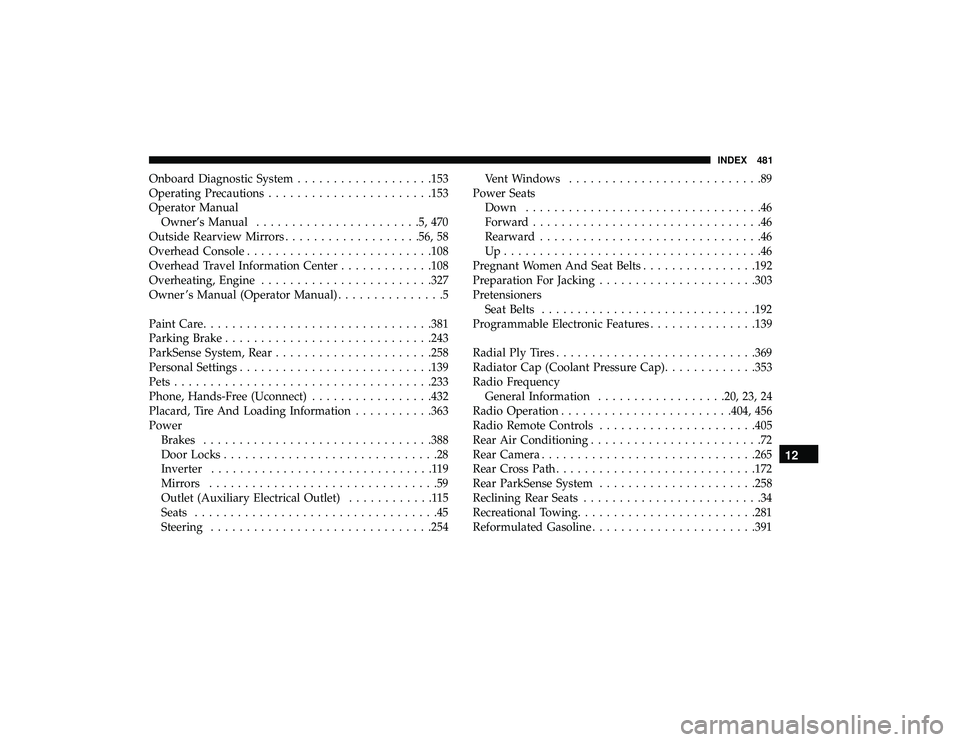2019 DODGE GRAND CARAVAN engine overheat
[x] Cancel search: engine overheatPage 351 of 490

WARNING!
•Exhaust gases can injure or kill. They contain carbon
monoxide (CO), which is colorless and odorless.
Breathing it can make you unconscious and can
eventually poison you. To avoid breathing CO, refer
to “Safety Tips” in “Safety” for further information.
• A hot exhaust system can start a fire if you park over
materials that can burn. Such materials might be
grass or leaves coming into contact with your exhaust
system. Do not park or operate your vehicle in areas
where your exhaust system can contact anything that
can burn.
CAUTION!
• The catalytic converter requires the use of unleaded
fuel only. Leaded gasoline will destroy the effective-
ness of the catalyst as an emissions control device
and may seriously reduce engine performance and
cause serious damage to the engine.
(Continued)
CAUTION! (Continued)
•Damage to the catalytic converter can result if your
vehicle is not kept in proper operating condition. In
the event of engine malfunction, particularly involv-
ing engine misfire or other apparent loss of perfor-
mance, have your vehicle serviced promptly. Contin-
ued operation of your vehicle with a severe
malfunction could cause the converter to overheat,
resulting in possible damage to the converter and
vehicle.
Under normal operating conditions, the catalytic converter
will not require maintenance. However, it is important to
keep the engine properly tuned to assure proper catalyst
operation and prevent possible catalyst damage.
NOTE: Intentional tampering with emissions control sys-
tems can result in civil penalties being assessed against
you.
In unusual situations involving grossly malfunctioning
engine operation, a scorching odor may suggest severe and
abnormal catalyst overheating. If this occurs, stop the
vehicle, turn off the engine and allow it to cool. Service,
including a tune-up to manufacturer’s specifications,
should be obtained immediately.
8
SERVICING AND MAINTENANCE 349
Page 355 of 490

•Mixing engine coolant (antifreeze) types is not recom-
mended and can result in cooling system damage. If
HOAT and OAT coolant are mixed in an emergency,
have a authorized dealer drain, flush, and refill with
OAT coolant (conforming to MS.90032) as soon as pos-
sible.
Cooling System Pressure Cap
The cap must be fully tightened to prevent loss of engine
coolant (antifreeze), and to ensure that engine coolant
(antifreeze) will return to the radiator from the coolant
expansion bottle/recovery tank if so equipped.
The cap should be inspected and cleaned if there is any
accumulation of foreign material on the sealing surfaces.
WARNING!
• Do not open hot engine cooling system. Never add
engine coolant (antifreeze) when the engine is over-
heated. Do not loosen or remove the cap to cool an
overheated engine. Heat causes pressure to build up
in the cooling system. To prevent scalding or injury,
do not remove the pressure cap while the system is
hot or under pressure.
(Continued)
WARNING! (Continued)
•Do not use a pressure cap other than the one speci-
fied for your vehicle. Personal injury or engine
damage may result.
Disposal Of Used Coolant
Used ethylene glycol-based coolant (antifreeze) is a regu-
lated substance requiring proper disposal. Check with your
local authorities to determine the disposal rules for your
community. To prevent ingestion by animals or children,
do not store ethylene glycol-based coolant in open contain-
ers or allow it to remain in puddles on the ground. If
ingested by a child or pet, seek emergency assistance
immediately. Clean up any ground spills immediately.
Points To Remember
NOTE: When the vehicle is stopped after a few miles/
kilometers of operation, you may observe vapor coming
from the front of the engine compartment. This is normally
a result of moisture from rain, snow, or high humidity
accumulating on the radiator and being vaporized when
the thermostat opens, allowing hot engine coolant (anti-
freeze) to enter the radiator.
8
SERVICING AND MAINTENANCE 353
Page 395 of 490

CAUTION!(Continued)
malfunctions can cause the catalytic converter to
overheat. If you notice a pungent burning odor or
some light smoke, your engine may be out of tune or
malfunctioning and may require immediate service.
Contact an authorized dealer for service assistance.
• The use of fuel additives, which are now being sold
as octane enhancers, is not recommended. Most of
these products contain high concentrations of metha-
nol. Fuel system damage or vehicle performance
problems resulting from the use of such fuels or
additives is not the responsibility of the manufac-
turer and may void or not be covered under the New
Vehicle Limited Warranty.
NOTE: Intentional tampering with the emissions control
system can result in civil penalties being assessed against
you.
Carbon Monoxide Warnings
WARNING!
Carbon monoxide (CO) in exhaust gases is deadly.
Follow the precautions below to prevent carbon mon-
oxide poisoning:
• Do not inhale exhaust gases. They contain carbon
monoxide, a colorless and odorless gas, which can
kill. Never run the engine in a closed area, such as a
garage, and never sit in a parked vehicle with the
engine running for an extended period. If the vehicle
is stopped in an open area with the engine running
for more than a short period, adjust the ventilation
system to force fresh, outside air into the vehicle.
• Guard against carbon monoxide with proper main-
tenance. Have the exhaust system inspected every
time the vehicle is raised. Have any abnormal condi-
tions repaired promptly. Until repaired, drive with
all side windows fully open.
9
TECHNICAL SPECIFICATIONS 393
Page 478 of 490

Checking Oil Level...................... .340
Compartment .......................... .339
Compartment Identification .................339
Coolant (Antifreeze) ..................... .398
Cooling .............................. .350
Exhaust Gas Caution .................. .234, 393
Fails To Start ........................... .242
Flooded, Starting ........................ .242
Oil ........................... .342, 397, 398
Oil Filler Cap .......................... .339
Oil Filter .............................. .343
Oil Selection ........................ .342, 397
Oil Synthetic ........................... .343
Overheating ........................... .327
Starting .............................. .241
Engine Oil Viscosity ........................ .342
Engine Oil Viscosity Chart ....................342
Enhanced Accident Response Feature .........207, 331
Ethanol ............................. .391, 394
Exhaust Gas Cautions ................... .234, 393
Exhaust System ....................... .234, 348
Exterior Lighting ............................61
Exterior Lights ...................... .61, 237, 287Filters
Air Cleaner ............................ .344
Air Conditioning ..................... .88, 345
Engine Oil ......................... .343, 398
Engine Oil Disposal ...................... .343
Flashers Hazard Warning ........................ .286
Turn Signals .................. .61, 152, 237, 289
Flash-To-Pass ........................... .61, 62
Flexible Fuel Vehicles Cruising Range ......................... .396
Engine Oil ............................ .395
Fuel Requirements ....................... .394
Maintenance ........................... .396
Replacement
Parts ....................... .396
Starting .............................. .395
Flooded Engine Starting ..................... .242
Floor Console ............................ .105
Fluid, Brake ............................. .400
Fluid Capacities ........................... .397
Fluid Leaks .............................. .237
Fluid Level Checks Automatic Transmission ................... .357
Brake ................................ .355
Power Steering ......................... .254
476 INDEX
Page 483 of 490

Onboard Diagnostic System...................153
Operating Precautions ...................... .153
Operator Manual Owner’s Manual .......................5,470
Outside Rearview Mirrors ...................56, 58
Overhead Console ......................... .108
Overhead Travel Information Center .............108
Overheating, Engine ....................... .327
Owner ’s Manual (Operator Manual) ...............5
Paint Care ............................... .381
Parking Brake ............................ .243
ParkSense System, Rear ..................... .258
Personal Settings .......................... .139
Pets ................................... .233
Phone, Hands-Free (Uconnect) .................432
Placard, Tire And Loading Information ...........363
Power Brakes ............................... .388
Door Locks ..............................28
Inverter ...............................119
Mirrors ................................59
Outlet (Auxiliary Electrical Outlet) ............115
Seats ..................................45
Steering .............................. .254Vent Windows
...........................89
Power Seats Down .................................46
Forward ................................46
Rearward ...............................46
Up....................................46
Pregnant Women And Seat Belts ................192
Preparation For Jacking ..................... .303
Pretensioners Seat Belts ............................. .192
Programmable Electronic Features ...............139
Radial Ply Tires ........................... .369
Radiator Cap (Coolant Pressure Cap) .............353
Radio Frequency General Information ................. .20, 23, 24
Radio Operation ....................... .404, 456
Radio Remote Controls ..................... .405
Rear Air Conditioning ........................72
Rear
Camera ............................. .265
Rear Cross Path ........................... .172
Rear ParkSense System ..................... .258
Reclining Rear Seats .........................34
Recreational Towing ........................ .281
Reformulated Gasoline ...................... .391
12
INDEX 481